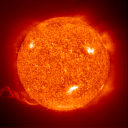Magnetic Fields Superheat Sun's Atmosphere
For decades, astronomers and mathematicians wondered why the atmosphere of the Sun is so much hotter than its surface. Now they've solved the mystery.
 They knew the surface of the Sun is a relatively cool 6,000 degrees Centigrade while our star's outer atmosphere -- the corona -- reaches temperatures of several million degrees.
They knew the surface of the Sun is a relatively cool 6,000 degrees Centigrade while our star's outer atmosphere -- the corona -- reaches temperatures of several million degrees.
What raises the temperature? Professor Eric Priest of St. Andrews University in Scotland with astronomers in Britain and France found that a clash of magnetic fields heats giant super-hot loops of gas that extend over the Sun's surface to produce the extreme temperatures.
The researchers used a telescope on Japan's Yohkok satellite to measure, for the first time, how the temperature varies along the giant loops.
They compared the temperature they observed with predictions from three theories. The observations matched a theory, which predicted that uniformly-released heat would clash with magnetic field lines generating dozens of explosions that release energy along the loop.
Like a Lightbulb. The explosions occur in tiny regions of intense electric current that heat the atmosphere in the same way as an electric current in a light bulb or electric fire.
| Sun and Sunspots Index Page | |||||
|---|---|---|---|---|---|
| Learn More about Our Sun and Sunspots and Their Effects on Earth |
| Read more Space Today Online stories about the Solar System | |||||
|---|---|---|---|---|---|
| Star: | The Sun | ||||
| Inner Planets: | Mercury | Venus | Earth | Mars | |
| Outer Planets: | Jupiter | Saturn | Uranus | Neptune | Pluto |
| Other Bodies: | Moons | Asteroids | Comets | ||
| Beyond: | Pioneers | Voyagers | |||
| Top of this page | Solar System index | Space Today Online cover |